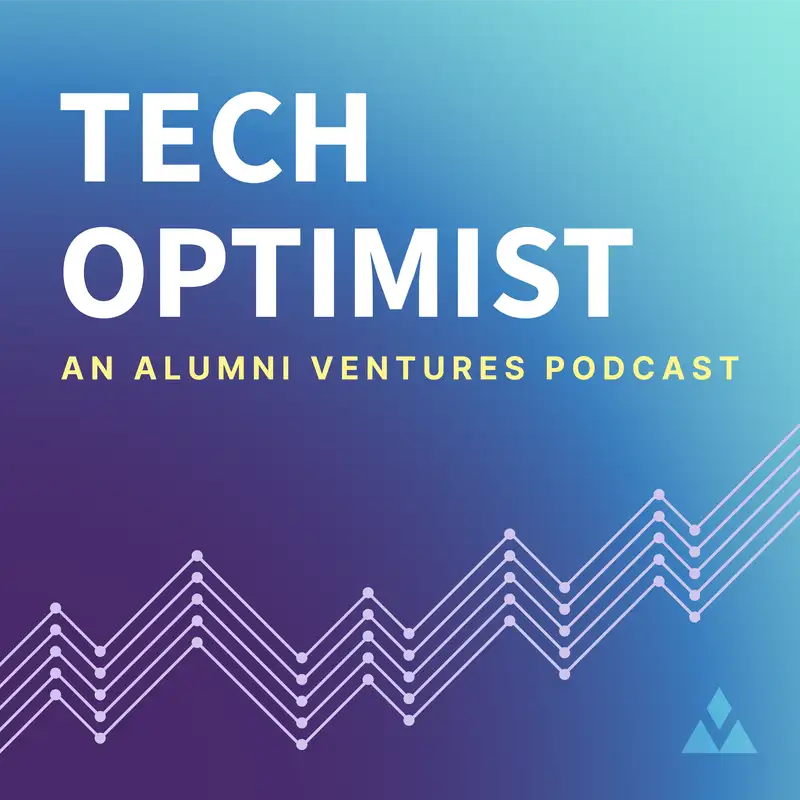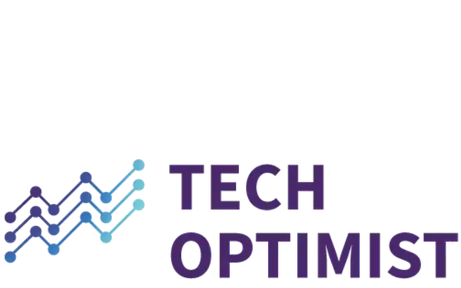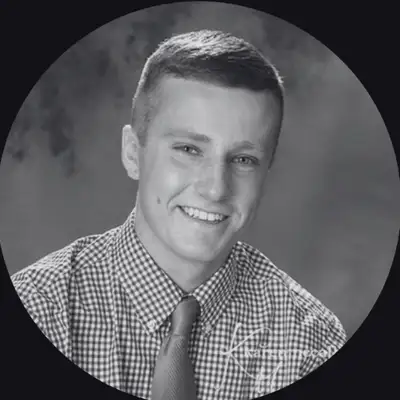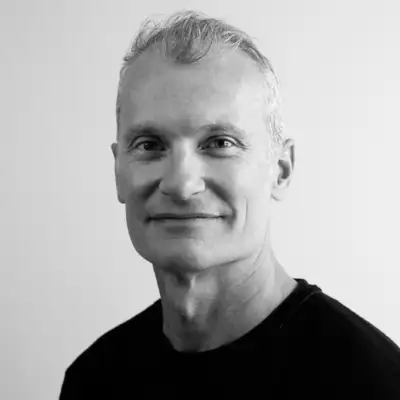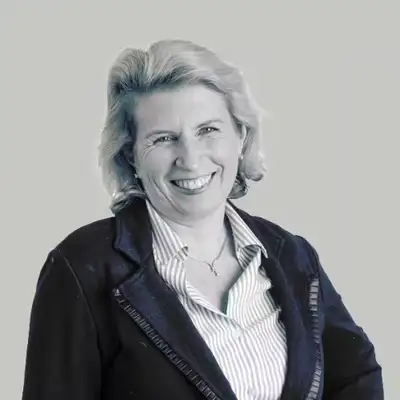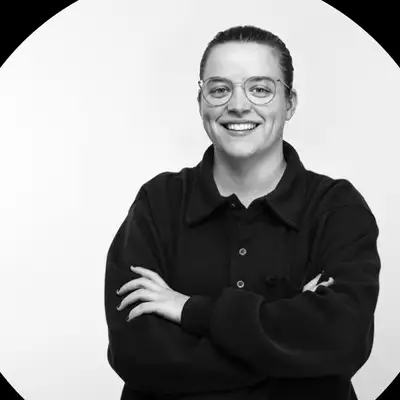#41 - Revolutionizing Warehousing: Meet the Start-Up Changing the Game
Sam Herrick:
The company we meet today helps you understand how to make your warehousing infrastructure more flexible. Yep, not fixed.
Laura Rippy:
Right, super strategic, right? I think I love the highlight of when a company is launching new products, or they're innovating.
Karl Siebrecht:
Circa a couple years ago, we've been on a journey to create a new position for Flexe. They're the relatively early innings of educating the market, flexible warehousing infrastructure, in contrast to fixed warehousing infrastructure. It is still part of your infrastructure. Our technology platform is plugged in.
Sam Herrick:
Hi, good morning, good afternoon, good evening. Welcome back to this episode of The Tech Optimist: Meet the Startup. Today, we meet Flexe. Our guide, or our host for today is going to be Laura Rippy, Managing Partner and Board Member at Alumni Ventures. Then our guest entrepreneur today is going to be Karl Siebrecht, CEO and Co-Founder of Flexe. Then you'll also hear my voice here and there. My name is Sam Herrick, and I will be your guide and tech note writer for this episode. Let's do it.
In a world captivated by criticism, it's easy to overlook the groundbreaking technologies shaping our future future. Let's shine a light on innovators who are propelling us forward. As the most active venture capital firm in the US, we have an exceptional view of tech's real world impact. Join us as we explore, celebrate, and contribute to the stories of those creating tomorrow. Welcome to The Tech Optimist.
As a reminder, the Tech Optimist Podcast is for the informational purposes only. It is not personalized advice, and it's not an offer to buy or sell securities. For additional important details, please see the text description accompanying this episode.
Laura Rippy:
Hi, everyone, it's Laura Rippy. I am Managing Partner at Alumni Ventures and thrilled to bring Karl Siebrecht and the story of Flexe here to all of you at AV in our Tech Optimist Podcast, we've been investors in Flexe for three and a half years, which is amazing. What I wanted to start off with, Karl, is if you can help us visualize a little bit more about what Flexe does, and then we'll get into your personal story as well. Just to kick things off for everyone, tell us a little bit about the Flexe platform.
Karl Siebrecht:
Very happy to do that, and it's good to see you again, Laura, and great to be here. Flexe, I'll try to use as little jargon as possible. Flexe is in the warehousing business. We provide warehousing services, kind of boring, I know it sounds like. We provide warehousing services to very large enterprise companies. What's unique about our business is we provide flexibility in warehousing.
If you zoom out for half a second and think about logistics networks and supply chains, goods move from a point of origin, whether that's in the far east, or in a factory in Mississippi, they move from a point of origin to a point of destination. Across a network, they flow from origin to destination. Logistics is all the investment, all the activity, all the business that happens to make that go from point of origin to point of destination. There are two rigid points in supply chains.
One is manufacturing, rigid, meaning there's a plant somewhere, and there's concrete, and there's steel, and there's assets, and there are warehouses that have concrete, and steel, and assets inside. Those are the fixed points in the flow of goods. In many cases, those become bottlenecks, because as the world changes around a company or around a new business line in the company, those are the spots that are hardest to react, or if you can predict that change, they're the toughest spots to move around, physical assets.
What Flexe does, and this is how we came up with the name 13 years ago, Flexe provides flexibility in warehousing. Specifically, we provide what we call flexible warehousing infrastructure, in direct opposition to typically the way warehouses work in the world is it's fixed infrastructure. That's what we do. You might imagine that if you're a big company, like a Nike, or a Lowe's, or a Starbucks, there are parts of your business that are maybe predictable, relatively stable, and then there are other parts where you're innovating, you're growing, you're changing.
It is in those parts of your business where the application of flexibility and warehousing makes tons of sense and unlocks tons of value. We are in the warehousing business, but we come at it with a unique capability.
Laura Rippy:
Right, super strategic. I think I love the highlight of when a company is launching new products or they're innovating, they need a partner that has flexibility, and you are from the ground up, that flexible platform for the warehousing piece. Love that. That's partly why, you've had some pretty long customer relationships, I know, and I imagine those sort of strategic partnerships are core to what you built. That's terrific. I guess we should-
Karl Siebrecht:
That's exactly right.
Laura Rippy:
Yeah. Let's start back a little bit, this is not your first rodeo, my friend. You are a serial founder, serial successful CEO. Part of why we love backing you, and I know we originally started our conversation because of the alumni connection from the Dartmouth Focus Fund, and your degree from Tuck really fits in with what we do at Alumni Ventures, but a big piece is backing amazing CEOs.
Maybe if you could share a little bit about your personal journey here as CEO, and what you bring to the table, and how that informs what you do.
Karl Siebrecht:
Yep. I didn't grow up thinking I would be a tech entrepreneur. I studied economics, studied Russian, was Navy [inaudible 00:06:20], so spent four years in the Navy, which was an amazing experience. Then went to business school, as you said, went to Tuck, go Tuck. After that, worked at Bain and Company in Boston where you are right now for a few years. Then a very, very close friend of mine started a business out here in Seattle. It was one of the very first advertising technology companies.
He started it in '97 when there was almost no monetization happening on the internet. In fact, there really wasn't that much activity on the internet. It was kind of an interesting debate whether this would ever amount to anything or not. For those who felt like this was actually going to grow, and the trend lines of actually audience minutes spent would continue to go up in the right, it would stand to reason that the world would have to figure out a way to monetize all the content that was being created and putting online.
Some people would bet that that was advertising. Of course now, I've long ago lost track of how many tens and tens and tens of billions of dollars were spent in advertising. I think Amazon just recently announced they alone are on a $54 billion trajectory for this calendar year. It's crazy, but that's not what we're here to talk about. I joined this very early company in ad tech, just because it sounded cool, it was an amazing team. A very close friend of mine had started it, as I said.
That ended up being a 10-year journey, where we had high highs and low lows. We almost didn't survive, but we barely did. It's kind of one of those stories, and it was amazing. Through that 10 year period, which culminated in a sale to Microsoft, where I spent a couple of years, there was no going back. There was absolutely no going back. I've worked at a handful of startups. I started one a few years later, and then came to the idea of Flexe.
I spent some time in another ad tech company. Anyway, after we sold that second business, I was on the beach, kind of catching my breath, and then started thinking about how am I going to try to recreate that magic, either starting a company myself, or joining another small company. We can get to the Flexe founding story here, but the foreshadowing is, I was talking to a guy at a housewarming party who said, "I've got an idea for you," which typically you might say like, "Oh, boy, here we go." This idea turned out to be the founding idea behind Flexe.
Laura Rippy:
Awesome. Yeah, wasn't it something like Airbnb for warehouse space or something in the very early, and now you guys have evolved since that, so that it's much more a partnership. Yeah.
Sam Herrick:
All right. I know we're all dying to hear this story. We're going to hear really quick, but one second. We got to do a sponsor spotlight really quick, and then we'll get right back into the answer and we'll hear that story. It's a really funny one, so you're not going to want to miss it. Hold on one second.
Laura Rippy:
Hey, everyone. Taking a quick break to share more about Green D Ventures. Green D Ventures is a venture capital fund built for the Dartmouth community with a portfolio of 20 to 30 investments intentionally diversified by sector, stage, and geography, and co-invested alongside renowned lead VC investors. We leverage our presence in the robust startup ecosystem of Dartmouth College alums to secure access to some of the most promising investment opportunities.
Green D is the first fund of Alumni Ventures, one of the most active and top performing VC firms in the US, and one of the only firms focused on making venture capital accessible to individual accredited investors like you. If you'd like to learn more about Green D ventures and access venture capital with a green Q, click the link or visit us at AV.VC/funds/GreenD. Now, back to the show.
Karl Siebrecht:
That's right. It captures the early essence. I'll do this quickly, in the ad tech business, the business model that we built was a marketplace model. There was a supply side of a network or a marketplace which were publishers, websites that had content looking to monetize it, and there was a buy side of a network which were advertisers. "Hey, I would like to find eyeballs to market my product."
We built a tech platform that allowed buying and selling to happen in a consistent and very scalable way for both sides. That was the essence of the business we built. Again, after 10 years, that business model and a lot of the dynamics behind it were etched into my brain. This idea for warehousing came along where the insight was, "Hey, when I lease a warehouse, I have to do it typically for multiple years, and when there is uncertainty in my business, I end up either long or short in space."
According to this guy who brought the idea and then became our first customer, he said, "Look, everybody operates in this way. Everyone's just sort of making bets, and they're either long or short. Man, it could be really valuable if you could create a market out of this. Someone's got too much space, you could make it available to somebody who needs more." That was the founding insight. We don't provide space, we actually provide the services.
Kind of like you think of an Uber, they don't provide you cars to drive around, they actually provide the service. I will take you from point A to point B. That's kind of in essence what we do. We provide big businesses like Nike with warehousing services to fuel things like shoe launches, the shoe drops. I could go on, but that's the essence of our building, and how it connects to the founding story.
It was a bit serendipitous, firstly, that I ran into a guy who had this idea. Secondly, that I had worked for, at this point, going on 14 years in a marketplace type of model, and heard about this idea, and was able to apply some past learnings to believe that I think this should be a big business.
Sam Herrick:
As we know by now, whenever I am researching each of these companies, I do a deep dive on their website. I do a deep dive in their webinars, if they have any, in their blog, if they have any, on their social medias, on their YouTube channel. Flexe has some really awesome videos from companies that they directly work with on their YouTube channel. I'm going to share a few of those now. They're each about three minutes long. I think it's really cool to hear the insights directly from Flexe's clients.
As mentioned earlier, Karl told us how the system works and how his business works, but I think it's really insightful to hear from the actual people that it's serving, and also definitely recommend a slew on their website, because they have a lot of really good information on their logistics, and as a company, how they work. Their branding is just overall really nice. Definitely recommend a little gander over there.
Speaker 4:
Hundreds of thousands of products launch every year, accounting for roughly 26% of annual revenue. Executing product launches flawlessly is critical. Ensuring that you're hitting street dates is something that can earn incredible amounts of trust with your customer.
Speaker 5:
For a successful product launch, the warehouse is important, the location of the warehouse is important, as well as making sure that you have the labor to support the product launch.
Speaker 4:
Ideally, a company should be able to launch their product without impacting any other standard operating procedures at their warehouses and within their supply chain on a day-to-day basis. This video game company came to us because they were looking at a very complex operational challenge, where they were going to need to stand up multiple warehouses in a short amount of time, just to be able to hit a street date that they had already promised to their customers.
Speaker 5:
The current 3PL could not execute on the amount of orders in the short period of time that it was expecting to reach the street. What makes Iron Mountain such a great partner for this program is first and foremost our mountaineers, our people that come to work here every single day. The second thing I would say is really our real estate footprint.
The most important thing for our customers besides the first two that I mentioned, is really our security, and how secure our facilities are. All of our buildings have cameras, there's CCTV, card keyed access, so it really enhances our value proposition compared to other providers that are in any type of business because of what our buildings are.
Speaker 4:
This video game brand was doing a two-phase launch. They were doing a pre-order phase with a hundred thousand units, and a live order phase with half a million units. Our dynamic ship on dates allow us to ensure that we are not shipping anything out prior or past when it would need to go out, in order to get right on a doorstep the day that we want it.
Paul Baltierra:
There's really tight timeframes in terms of when the inventory gets here. We go from making boxes, to packing them, to labeling them, to getting them on the truck. What really helps us with the Flexe system is the custom batch waving, especially with the multi-line items, different SKUs, and also the QR code. If we have a certain order that has a large amount, we can just scan one QR code instead of scanning the same SKU number over and over again. The Flexe system, it's extremely easy to use. As soon as people come in, we can show them how to do it, and they're using it that same day.
Speaker 4:
This is our sixth product launch with this brand. With each launch, they increase the number of units that they want us to handle, and they keep coming back.
Speaker 5:
With these different launches that this brand has, it has these spikes in what they're doing, so it won't disrupt their current provider for handling their everyday customers. Where on these launches that spike up and down, Flexe and Iron Mountain can handle pretty much on demand.
Speaker 4:
By choosing Flexe and Iron Mountain to supplement their supply chain, this brand has been able to execute their product launches to fulfill the dreams of their most passionate fans.
Laura Rippy:
Such a perfect fit you are. Experience as a CEO experience in building that marketplace, understanding of the logistics, the brain power between all your degrees, and Bain background, and experience in the Navy, so amazing, so amazing. We're really appreciative of all that you bring here. Your company is a little later stage than some of the other ones in the Alumni Ventures portfolio.
We do a lot of seed and A, your company is further along. What wisdom do you have for founders that are earlier in their building, so they know they can get as far along as Flexe has built in the journey? Any insights there?
Karl Siebrecht:
I'll tell you, I have one that is sort of very business related, and two, which is more just sort of human related. The first one is I'm a huge advocate for focusing, and refocusing, and refocusing attention on identifying your target customer segment. It's sort of like marketing your business 101, but I can't emphasize how important that is, particularly in a startup where there's a lot of uncertainty, you're kind of inherently making bets because you don't have enough data early on to make hardcore quantitative decisions on every dimension of the company.
You've got to pick some bets. Customer segment is, I would say, first and foremost, because your customer segment will determine the feature set you build. It will determine, of course, your go-to market. It will be one of the fundamental tenets that will help you make follow-on decisions, again, in an environment often where you just don't have as much data as you would like.
Customer segment, in a moment of uncertainty, come back to that question, "Who is my customer segment? Do I still have conviction that that's the right one? Do I have a compelling, unique value prop for that segment?" The other one is, I don't know, I feel like it's pretty tired or overused, but I'm a big believer in the importance of just perseverance. It's a long journey. If you want to build a company, one of my favorite books of all times, business books of all times is Ben Horowitz's The Hard Thing About Hard Things.
It's just this amazing novel about just really how hard it is. You have to really embrace that and be fueled by that, in my view. Again, right when things are going great, it can be the case that you get thrown a curveball that's a bit rough or very rough. If the journey and anticipation that it will have a lot of curveballs isn't a big part of the joy, then man, there's a lot of other great jobs out there. There's a lot of other ways to spend your time professionally if that's not really what fuels you.
Laura Rippy:
Right, right. It helps fuel the company too, right? Creates the moats. If you're tackling the hardest things, if you have the grit to power your team through those tough things, that creates the moats for your company. There's a lot of benefits there.
Karl Siebrecht:
Exactly.
Laura Rippy:
I know you're in Seattle. You and I share Seattle as well, not where I live now, but certainly fan girl here. What do you think the current climate is in Seattle for startups? How would you categorize it?
Karl Siebrecht:
It's, I think, coming back, but I think similar to many other places, and you spend a lot more time in this ecosystem, early stage startup land than I do these days, people are still a little gun shy, I think. Obviously, there's massive amounts of activity in AI world, but that also comes with just a lot of... It's hard, I think, to figure out where's the value. I was reading something the other day where an investor made the comment, "When you're looking at these startups, you need to evaluate, are they the disruptor or the disruptee?"
I don't know how you do that. I know there's a lot of really smart people who spend a lot of time in it. There's activity around that here in Seattle, as there is everywhere, but I feel like there's still just kind of some caution and a lot of tentative behavior and thinking.
Sam Herrick:
All right, one more ad. Hang tight.
Speaker 7:
Do you have a venture capital portfolio of cutting edge startups? Without one, you could be missing out on enormous value creation and a more diversified personal portfolio. Alumni Ventures, ranked a top 20 VC firm by CB Insights, is the leading VC firm for individual investors. Believe in investing in innovation? Visit AV.VC/foundation to get started.
Laura Rippy:
Fair, fair. We're all kind of finding our way here, and obviously, AI is particularly strong in Seattle, and Madrona and other places lead, but it is a market where you have to have your eyes wide open and definitely choose well. Okay, so this is my favorite part, which is your ask to the alumni Alumni Ventures community.
How can we be helpful? You need help with hiring? Is it that center of the bullseye introductions? How can the community help you, Karl, and Flexe?
Karl Siebrecht:
Yeah, if I can wave my magic wand and recruit the Alumni Ventures investor base for the cause, it is, we are 11 years into this journey with Flexe, which is just hard for me to believe, 11 years. We started it actually in my basement, not my garage, but my basement, three of us around a coffee table, one of those with the folding legs. That's where we started. In that journey, we have been beating a drum around educating the market, the world, to the degree we can, around the value of flexibility in warehousing.
The first chapter, if you will, of our business, we isolated for our target customer segment, again, eating our own dog food there, but we targeted a position. We created a new category, and we called it on demand warehousing. That was a very purposeful, lots of iteration, lots of market testing on that to try and bring to life what's different about what Flexe does, on demand warehousing.
This is when there were on demand taxis, there were on demand all kinds of things. We plugged into that, and it actually worked really, really well. After a few years of beating the drum, Gartner, Gartner has a big supply chain practice, they started talking about this new category on demand warehousing. Guess what? There's a company in Seattle called Flexe, and they're the leaders, and that's great. Now, there's also a problem with that, is that we painted ourselves into a bit of a corner.
If I had to do it all over again, I would do it all over again, just to be clear, but we painted ourselves in a corner, because for on-demand warehousing connotes to many people, frankly, most, is that, "Oh, this is a surge capacity. I've got my actual capacity, my fixed capacity, if you will, my leases, my warehouse I lease. Then if things don't go to plan, or there's some kind of disruption or seasonal peak, oh, I'll look to this other thing, and just use it for surge on demand."
We are the first call that most of these big customers make when they need that. The problem is, we offer a significantly broader set of applications that are much more strategic, multi-year solutions for the customer, which also looks like much better recurring revenue for the business. Circa a couple of years ago, we've been on a journey to create a new position for Flexe, and we are still in what I would consider the relatively early innings of educating the market: flexible warehousing infrastructure, in contrast to fixed warehousing infrastructure.
It is still part of your infrastructure. Our technology platform is plugged in to your ERP system. We are plugged into your planning process. On a quarterly, annual, multiyear basis, our customers are considering, "Where are the best places to deploy flexible infrastructure in my supply chain, and where are the best places to have fixed?" That's a journey we're on. I know this is a long answer to get to the ask, but the ask is to help us with that education.
What is flexible warehousing infrastructure? "Hey, it's actually possible to have flexibility and warehouses, and what is the value of that?" One of the chief supply chain officers, and I'll keep this anonymous, of one of our best customers, who, their company has been using this for years, is I was actually bouncing this position, this new category, flexible warehousing infrastructure off of him a while back, and we talked about the contrast. He says, "Okay, so if I could get flexible warehousing infrastructure, why would I ever want fixed? Why would I ever anchor myself?"
I said, "Thank you very much. Can you please tell all your friends?" To the audience here, to the investor community, tell all your friends, there's this company called Flexe. If you could get flexible warehousing infrastructure, flexible infrastructure, why would you ever want fixed? Bingo.
Laura Rippy:
Love that. It just speaks to the strategic nature and the depth of those partnerships you've had for so many years. I have to believe that that is the kind of strategic relationship that folks have when it's flexible warehousing infrastructure. Those are the longterm, really sticky, high quality relationships that you guys represent, and that we'ev-
Karl Siebrecht:
That's exactly right.
Laura Rippy:
... Been so pleased to invest with you. Okay. Well, I love it, Karl. This has been a treat. We'll talk again soon, and thanks for taking the time to share the Flexe [inaudible 00:27:38]-
Karl Siebrecht:
It's my...
Laura Rippy:
... Story. Yeah.
Karl Siebrecht:
... My pleasure, Laura. It's great to see you, and thanks for the invite to be here.
Laura Rippy:
Take care. Thanks.
Karl Siebrecht:
Bye-bye.
Sam Herrick:
Thanks again for tuning into the Tech Optimist. If you enjoyed this episode, we'd really appreciate it if you'd give us a rating on whichever podcast app you're using, and remember to subscribe to keep up with each episode. The Tech Optimist welcomes any questions, comments, or segment suggestions. Please email us at Info@TechOptimist.vc with any of those, and be sure to visit our website at AV.VC. As always, keep building.
